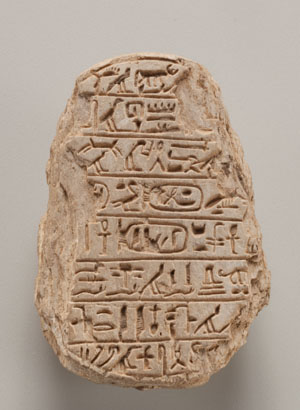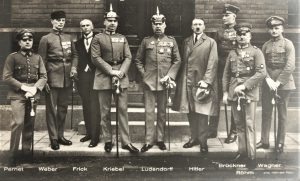The word hieroglyph stems from two Greek words; hiero meaning holy and glyphs meaning writing. In 1799, the French Captain Pierre Bouchard discovered the Rosetta Stone, which had two languages on it.1 The stone was carved with the same text in two different languages, Greek and Egyptian, and in three different writing systems, which included hieroglyphic. With the finding of the Rosetta Stone, scholars were able to unlock the hieroglyphic code. Hieroglyphs were the earliest form of Egyptian formal writing that combined logographic and alphabetic elements. The writing was used from around 3200 BCE until about 395 CE. The writing incorporated between 700 and 800 symbols in it, and not every Egyptian was able to read or write it.2
The supplies used to write hieroglyphics were quite similar to the supplies that we use to write today. The Egyptians wrote hieroglyphs on papyrus reed. Papyrus reeds were water or marsh plants with tall straight hollow stems that were flatten, dried, and stuck together to make pages. They utilized a pen and ink to write on the fine papyrus paper. The pens that they used were thin sharp reeds that they dipped in ink. The ink that they used came from crushed plants that they mixed with water. The hieroglyphic system was written in long lines, usually from right to left or top to bottom. The direction in which it was read relied on which way the human or animal figures were facing. The direction in which they were facing indicated the beginning of the line.3 No spacing or punctuation were used. It was divided into two main groupings of writing; phonograms, and ideograms with incorporated determinatives into it. The phonograms were the glyphs that represented sound in the writings and represented single constants and combinations of constants. The ideograms represented objects and ideas that they were trying to convey. They either represented the actual object written or something that was closely related, such as legs for movement. The writing also utilized determinatives. Determinatives were hieroglyphs that were not spoken or translated but helped make the meaning of the word clearer. Determinatives were also used at the end of words to indicate the end of a word, as the Egyptians did not place spaces between words or sentences. Some symbols utilized within the writing could represent an entire sentence or saying. The Egyptian writing did not utilize the use of vowels, so it is impossible to understand exactly how they pronounced hieroglyphic texts.

The Egyptians would use their hieroglyphic writing on a variety of locations and documents. They would use the writing in schools, on tombs, and on temple walls. As most Egyptians could not read or write, only the privileged class, such as royals, nobles, and priests, along with scribes could read or write hieroglyphs. Scribes were Egyptians that went to a special school and were trained to write and read the writings. Egyptian priests also used hieroglyphics to pen prayers, prepare tomb stone surfaces, and for guides of the afterlife placed on the inside of their deceased coffins. Many Egyptians believed that writing hieroglyphics on their tombs and in their coffins would help lead the dead to the afterlife.4
Civil officials would utilize the writing to write royal documents of long-term importance, record historical events, and document important calculations. An example of an important calculation that the Egyptians would record using the writing would be the depth of the Nile River on specific days of the year. Lastly, they carved hieroglyphic symbols on their jewelry to decorate it and other luxury items that they posed.
In conclusion, deciphering the Egyptians hieroglyphics has provided much important information about the way of life in ancient Egypt. The Egyptians felt it was important to document and communicate important facts about their religion, government, and daily lives. By utilizing hieroglyphic writing, the Egyptians were able to preserve their history, ideas, and beliefs, and help us see how they lived.
- Ancient History Encyclopedia, July 2015, s.v. “Egyptian Hieroglyphs,” by Priscilla Scoville. ↵
- Ancient History Encyclopedia, July 2015, s.v. “Egyptian Hieroglyphs,” by Priscilla Scoville. ↵
- Encyclopedia Britannica, November 2015, s.v. “Hieroglyphic Writing,” by Peter F. Dorman and Hellmut Brunner. ↵
- Encyclopedia Britannica, November 2015, s.v. “Hieroglyphic Writing,” by Peter F. Dorman and Hellmut Brunner. ↵



33 comments
Sofia Perez
Hi Jamarillo! Short, but very informative and interesting article. Right before I went into my sophomore year of high school I went to Europe and went to the British Museum. Now I was not able to see the whole museum because of how big it is, but I did see the Rosetta Stone and other Egyptian artifacts. I think if I read this article before going to the museum, would have had a deeper connection and understanding to some of the pieces with hieroglyphics.
Kimberly Rivera
It is quite amazing to see how even in the Ancient Egyptian period there was a need, a want to leave and document the most vital facts of their time and life and thanks to that we can learn increasingly more about them and their traditions and way of life. Even if Hieroglyphs is a hard writing system to learn and write in, I still cannot help but to be fascinated about it and its functions.
Meadow Arriaga
Hieroglyphs are so complicated to read compared to todays date writing. The Egyptians made these writings out of materials that would secure them. The writings became permanent which I find interesting. These people found their events so important, they documented it so it could live forever. If most of the people of Egypt could not read these, the writings were made for superior Egyptians.
Juan Arceo
Like cuneiform, hieroglyphs were very instrumental in developing the language system of today. It is fascinating that with just images and drawings that were done, an entire story could be told, which honestly at times, reminds me of texting with emojis. Some people can deliver the message with a couple of emojis and that could be said was the same principles in Egypt during those times.
Matthew Swaykus
This article was very interesting. The author describes hieroglyphs to such an extent that the reader can see that information about the hieroglyphs is either rare or from another source. This is clearly demonstrated when the author breaks apart the world hieroglyph into Greek worlds, and when the author simply states that we can never truly know how the Egyptians pronounced words because their language only consists of consonants as far as we know.
Hali Garcia
Hieroglyphs have always been interesting with me and after reading this article, I have a new understanding of them. I never knew that not all Egyptians would use them and I guess I should have. It is interesting learning about how they were written and how their writing utensils were made. Now I know that the symbols are facing the way they should be read and what signals the end of a word or phrase.
Uzziyah Cohen
This article offered excellent insight into hieroglyphics and Egyptian writing. I was amazed at how much the world was able to gain from the Rosetta Stone itself. The Rosetta Stone was, in fact, a crucial key to unlocking the translation of Egyptian writing and lead to much of our acquisition of understanding Egyptian culture language and life itself. I also found it intriguing that Hebrew seems to follow the pattern of the hieroglyphs in the use of the system utilizing consonants and no vowels.
Christopher Metta Bexar
The importance of the Rosetta Stone and the clues into Egyptian hieroglyphics was the first real chance for Europeans to understand the culture of Ancient Egypt and other parts of the Middle East. Before that it was mainly conjecture.
It not only assisted in helping Europeans understand Egypt but illustrated the ties between modern man and his ancestors. That we had laws and education thousands of years ago.
Damian Jennings
I respect the older cultures and what we believe seems so write and everyone else way seems so foreign and non realistic but understanding the culture and concepts that go hand and hand with each other gives a better representation of a culture. Being open minded can lead to more knowledge and exploring different culture is important. Thats what this article did, well done
Annissa Noblejas
The 1799 discovery of the Rosetta stone unlocked the ancient hieroglyphics puzzle. Using symbols that represented both sounds and ideas, the ancient Egyptians compiled a complex writing system. However this written language was not a wide spread skill available, like many cultures only the elite had learning access. While the writings remain on a variety of platforms, there is no surviving pronunciation.